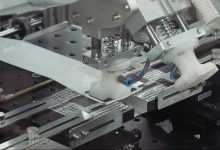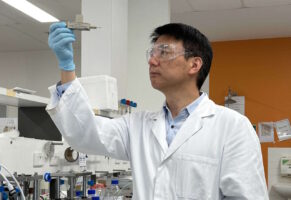Australian scientists have made a major advance in battery materials that could provide a pathway to energy storage devices with higher storage potential and increased performance, while also increasing their resistance to fire.
The research breakthrough has been achieved by researchers at Deakin University, working in collaboration with Monash University, and have used combinations of new “liquid electrolytes” and lithium metal electrodes to boost both battery capacity and safety.
“Over the past 30 years, researchers at Deakin and Monash University have been working on a new class of electrolyte material called an ionic liquid, which is a salt that takes on a liquid form at room temperature,” Deakin University’s professor Patrick Howlett said.
“These materials have some unique properties that have begun to attract widespread interest in the battery community, due in large part to the work done at Deakin.”
Most rechargeable batteries used for small and large-scale battery storage devices use commonly available lithium-ion battery designs. These designs traditionally use electrolysers consisting of dissolved salts or organic solvents, which can lead to increased volatility and flammability during the battery’s chemical reactions.
But the Deakin University researchers have developed a viable alternative technology, using “ionic liquid electrolytes” to overcome these problems, that allow for similar battery performance, while providing advances in battery safety, temperature stability and performance at higher voltages.
The researchers have successfully produced a 1 Amp-hour working example of a lithium metal pouch cell that demonstrates the ability of the new materials to deliver performance and safety improvements.
The iconic liquid electrolytes is a form of salt that acts as a liquid at room temperatures. The researchers expect that the new electrolytes will open the door to new battery designs that will help increase battery storage capacity, as well as allowing for faster discharge rates.
The innovative electrolytes also help to significantly reduce the impact of fire on the battery devices.
“Ionic liquids are non-volatile and resistant to catching fire, meaning that unlike the electrolytes currently used in lithium-ion cells used by, for example Samsung and Tesla, they won’t explode. Not only that, but they actually perform better when they heat up, so there’s no need for expensive and cumbersome cooling systems to stop the batteries from overheating,” professor Patrick Howlett added.
The new materials have been developed by Deakin University’s Institute for Frontier Materials.
The researchers hope that the new designs will continue to attract the interest of major battery manufacturers, particularly as demand for energy storage and electric vehicles continues to grow.
“If we change the electrodes to include lithium metal we can increase the storage capacity for up to 50 per cent longer run-times. When we change the electrolyte, it can give a higher discharge rate or allow the battery to operate at much higher temperatures – but the electrolyte must be compatible when in contact with the reactive lithium metal electrode,” Deakin University research fellow Dr Robert Kerr said.
“By choosing the right electrolyte chemistry we can completely avoid the catastrophic explosions caused by ignition of the volatile electrolyte when the cell is damaged or overcharged.”
The research has been accelerated following the formation of Deakin University’s Battery Technology Research and Innovation Hub, which was formed in 2016 with the support of the ARC Centre of Excellence for Electromaterials Science.
The next steps for the research will be to progress the pathway to the commercialisation of the innovative battery designs.
“The use of lithium metal electrodes in lithium metal batteries isn’t common in the battery industry, so there’s little known about the best way to manufacture these cells at practical levels for demonstration,” Dr Kerr added.
“After years of painstaking attention to manufacturing processes and details, the team has achieved a benchmark level that’s sure to make everyone in the industry sit up and take notice.”
“While this is just a stepping stone on the way to 1.7Ah cells, which are soon to be in production, this is an important milestone in the battery world for the demonstration of a new technology.”
RenewEconomy and its sister sites One Step Off The Grid and The Driven will continue to publish throughout the Covid-19 crisis, posting good news about technology and project development, and holding government, regulators and business to account. But as the conference market evaporates, and some advertisers pull in their budgets, readers can help by making a voluntary donation here to help ensure we can continue to offer the service free of charge and to as wide an audience as possible. Thankyou for your support.










